Why Has Asia Been Hit So Hard By The Global Economic and Financial Crisis? Presentation by Mr. Takatoshi Kato, Deputy Managing Director, IMF, at the Eighteenth General Meeting of the Pacific Economic Cooperation Council
May 12, 2009
At the Eighteenth General Meeting of the Pacific Economic Cooperation Council
The Mayflower Hotel, Washington, D.C.
May 12, 2009
As prepared for delivery
| Download the presentation (503 kb PDF) |
1. Let me start by saying that it is a pleasure to participate in the Eighteenth General Meeting of the Pacific Economic Cooperation Council. It is an honor to be a part of this distinguished panel of experts. My presentation will be about the global economic and financial crisis and why the Asia region has been hit so hard.
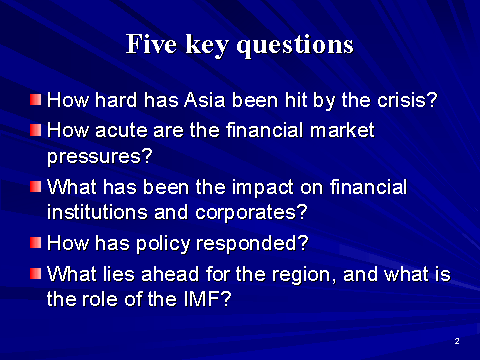
The presentation is organized around five key questions. First, how hard has Asia been hit by the crisis? Second, how acute are the financial market pressures? Three, what has been the impact on financial institutions and corporates? Four, how has policy responded? And five, what lies ahead for the region, and what is the role of the IMF?
A. How hard has Asia been hit by the Crisis?
2. Asia has suffered adverse spillovers from the crisis.
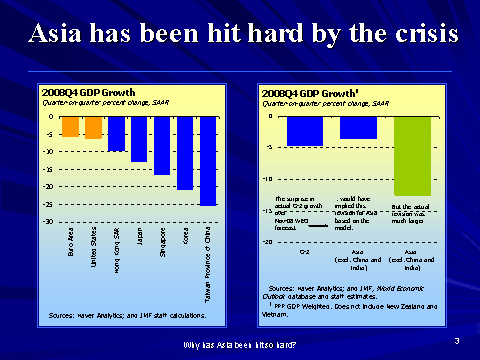
• The abrupt deceleration in growth in Asia has been more rapid than in other regions, and in key countries even sharper than at the epicenter of the global crisis. In the fourth quarter of 2008, GDP in Asia, excluding China and India, plummeted by close to 15 percent on a seasonally-adjusted annualized basis.
• Economic activity in key countries has decelerated significantly faster than anticipated by IMF staff and professional forecasters. The intensity of the downswing has also outstripped what IMF models predict on the basis of the historical correlation between the business cycles in the G2 countries and the region.
3. In broad terms, Asia has been hit hard because of its integration with the global economy.
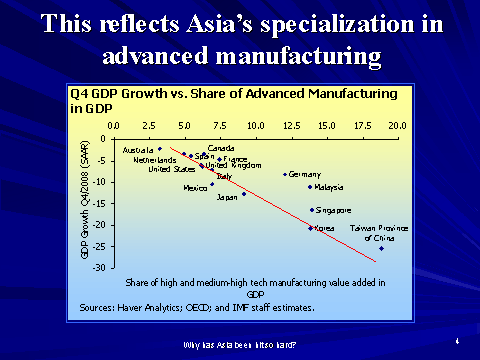
4. The collapse in demand has been transmitted through the integrated supply chain with dramatic effects on intra-regional trade. Even service-oriented economies—which provide logistical and financial support (such as Hong Kong, SAR, and Singapore)—have been hard hit as demand for their services has dropped.
5. The external shock has fed through to domestic demand as well.
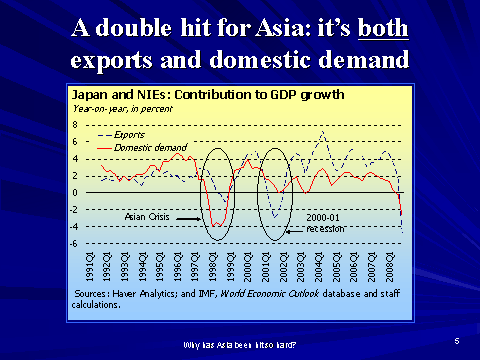
6. The story on China is somewhat different.
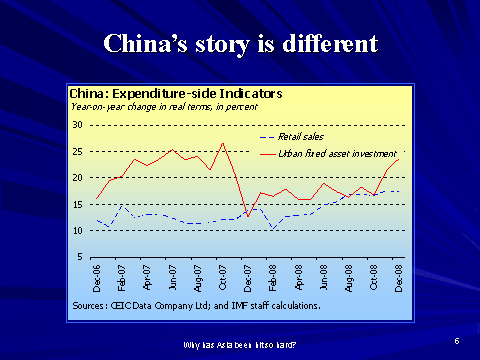
B. How acute are the financial market pressures?
7. Asian financial markets have been significantly hit by global deleveraging.
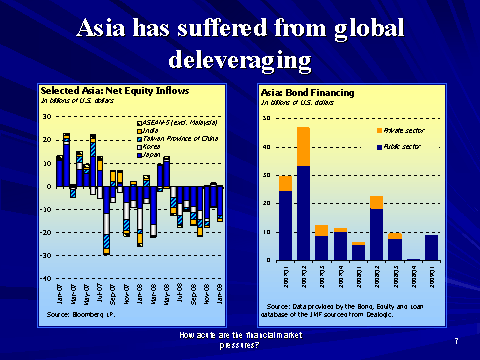
8. For much of the region, the large buffer of reserves has provided a strong cushion against a further deterioration in external financing conditions.
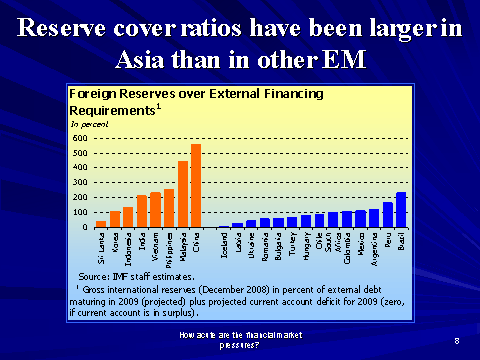
9. However, the case of Korea, illustrates how even a country with a large reserve cushion, a comfortable current account position, and a strong policy framework, can be hit hard by the crisis.
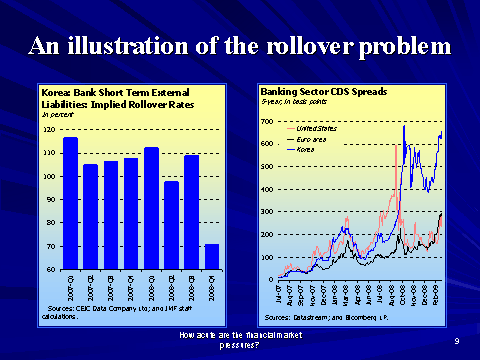
Korean banks accumulated substantial short-term foreign currency debt in recent years. As cross-border lending was curtailed in the last four months of 2008, Korean banks have had considerable difficulty in rolling over their external debt, forcing the Bank of Korea to step in with foreign exchange swaps to alleviate funding pressures. At the same time, foreign investors have withdrawn from domestic equity and bond markets as risk aversion spiked, leading to a substantial depreciation of the exchange rate. Encouragingly, the rollover of Korean banks’ external liabilities has improved substantially in January and the first half of February, 2009.
10. As financial activity worldwide has shrunk, the region’s financial centers have also been broadsided.
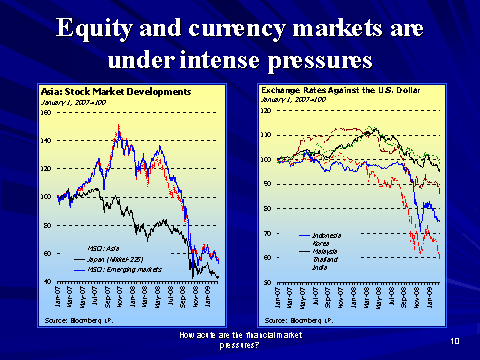
Hong Kong, SAR’s financial system is contracting, particularly in areas such as asset management and brokerage services. In Singapore, bank intermediation has been affected, particularly in the Asian Dollar Market, where lending to non-bank customers has been contracting recently. In Japan, stricter lending standards, wider risk spreads, and the significant stock market declines have tightened financial conditions.
C. What has been the impact on Asian corporates and financial institutions?
11. The crisis is taking an increasing toll on Asia’s corporate sector.
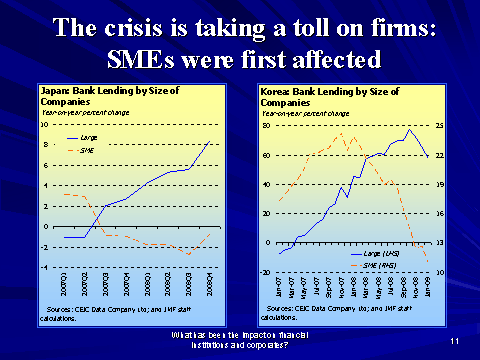
12. Large Asian corporates, like their U.S. counterparts, entered the crisis with strong balance sheets. When the demand shock hit, corporates faced little immediate pressure to scale back their activities or cut costs. However, liquidity positions have since dwindled.
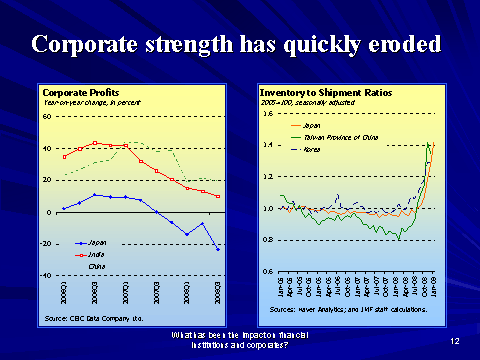
A credit crunch combined with a sharp fall in demand can quickly put a healthy corporate sector into trouble, and profits can quickly evaporate.
13. If this trend continues, and demand does not recover, large Asian corporates will need to further retrench production.
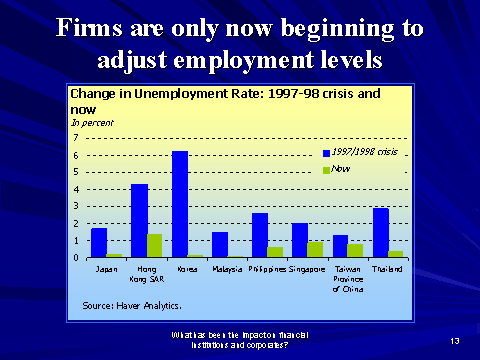
14. Corporate risks are rising and market indicators are flashing warning signs. There are signs that even the best Asian corporate “names” are being rationed out of financial markets and are considering approaching their government for direct assistance.
D. How has policy responded so far?15. Regional policymakers have generally responded aggressively.
• Central banks have cut interest rates over the last few months.
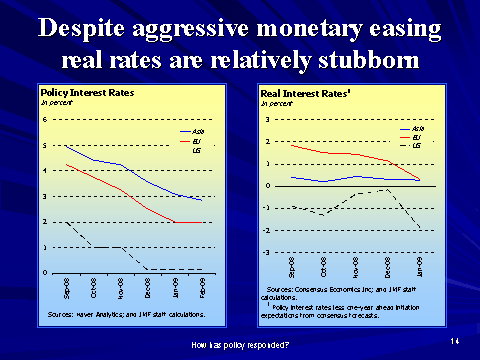
The easing cycle started later than in the United States, but has accelerated since last September. However, the rate cuts have been largely offset by declining inflation expectations, so that real interest rates have remained relatively constant in a number of countries. Moreover, greater caution by banks and rising risk premium have weakened the traditional monetary transmission mechanism. An exception is China, where considerable monetary policy easing has already led to a surge in lending.
• Some countries now are at or close to the zero interest rate constraint on monetary policy. As a result, central banks are turning to unconventional measures, which have expanded balance sheets.
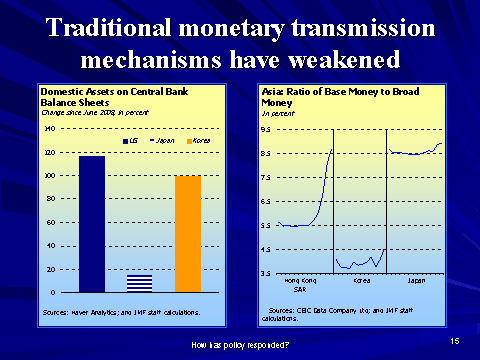
Nonconventional (credit easing) measures in Japan, and Korea, for example, aim to reduce risk premium and unlock activity in credit markets. Despite these efforts, broader measures of money supply contracted, and term interest rates remain stubbornly high in several countries.
• Nearly all governments in the Asia-Pacific region have introduced multiyear fiscal stimulus packages to support growth.
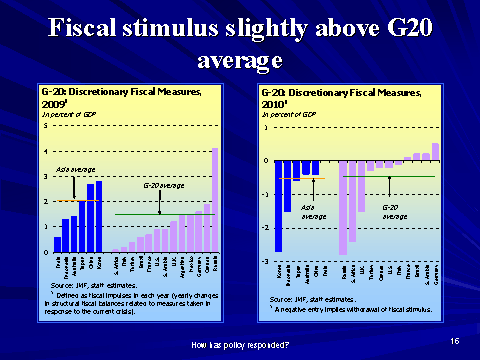
Thanks to sound policies and a historical preference for conservative fiscal policies, many countries entered the crisis with significant room for countercyclical fiscal support. The average size of discretionary fiscal measures taken in the region is slightly above the G20 average for 2009, and the reduction of the stimulus in 2010 about the same as the G20 average. The success of these packages will depend, in part, on the propensity of consumers to spend, and the ability to overcome spending implementation constraints.
E. What lies ahead in the region?
16. The current crisis vividly illustrates that Asia has not “decoupled” from the global economy. Moreover, although efforts are being made to invigorate domestic demand, the prospects of a recovery at this stage continue to hinge critically on a rebound in global activity.
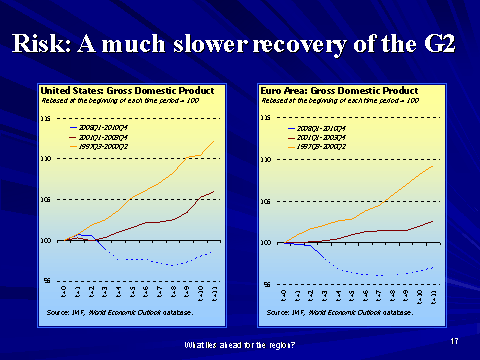
So, it will be important for Asia that the world avoids a serious outbreak of protectionism, either trade or financial. The risks are across several fronts:
• First, the longer that export demand remains weak, the greater the risk that contamination feeds into domestic demand.
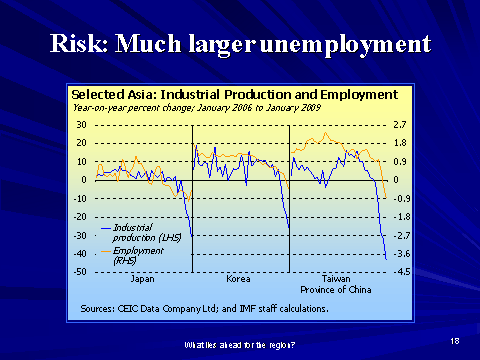
Private consumption has, so far, held up relatively well as labor markets have not yet adjusted to the new global realities. Consumption has also been helped by real income gains from lower commodity prices—notably oil—and the buffer provided by high household savings. But our sense is that an inevitable significant adjustment in employment is coming. Already, unemployment has started to climb across the region and potentially high social costs from this downturn are a looming threat.
• Second, the feedback loop between the financial and real sectors is expected to play out. Given the likely prolonged nature of the downturn, non-performing loans are likely to rise. This will feed into bank balance sheets.
• Third, the era of easy credit to finance purchases of new automobiles and consumer electronics in industrial countries is likely over. When the global economy eventually recovers, the level of demand for Asian manufacturing and exports could well be structurally lower for many years. In that world, Asia’s export-led growth strategy may no longer pay the same dividends as in the past. Asian economies need to look much more at their own domestic economies and find ways to capitalize on their comparative advantages and foster local demand.
• Finally, some of the smaller vulnerable economies in Asia could fall into full-blown financing crisis. Those countries that have not put in place a sound institutional basis for policymaking are now going to face the leading edge of the global crisis. Countries where public debt is high, current account deficits are large, and which have allowed maturity and currency mismatches to fester in bank and corporate balance sheets need special watching.
17. Despite all these risks, there is some evidence that the rate of deceleration in the global economy is abating.
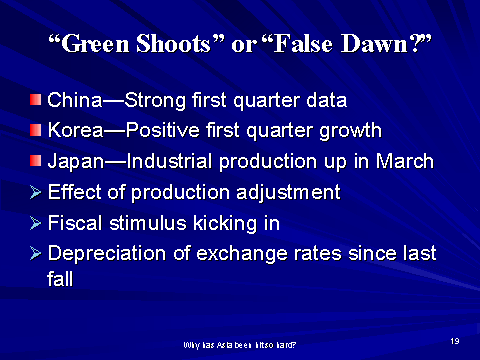
The real question is whether the evidence represents “green shoots,” or “false dawn.” In Asia’s context, for example, China has seen a strong first quarter with respect to industrial production, retail sales and credit growth. In Korea, first quarter GDP was up by 0.1 percent. In Japan, March 2009 industrial production increased by 1.6 percent.
18. Though tentative, these “green shoots” in Asia may reflect the following. One is that several regional exchange rates have depreciated since last year, and this should help regional exports. Of course, its effect will ultimately depend on the recovery in demand in the main export markets. Second, Asian corporates have been aggressively reducing inventories and excess capacity in the manufacturing sector, and so may be reaping the benefits of a stabilization in global demand. Finally, the unprecedented policy response to the crisis so far has helped contain the spillovers from the external shock to domestic demand, and the effects of the stimulus packages may be finally kicking in.
19. Let me conclude by saying a few words about the role of the Fund in helping Asian countries, and more generally, the global economy rebound from the global crisis.
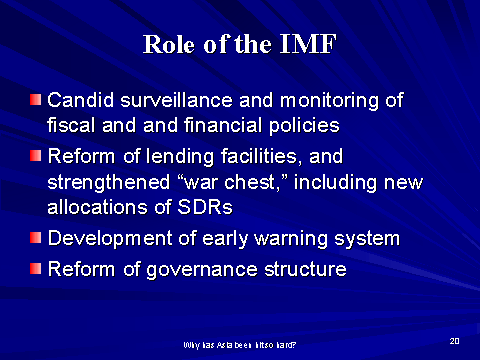
20. There was consensus at the recent G20 Heads of Governments Summit in London that the IMF should play a pivotal role in helping the global economy overcome the current crisis. I will emphasize 4 points. First the IMF should provide candid, even-handed independent surveillance, including the monitoring of fiscal and financial policy implementation of member countries. Second, the IMF should continue efforts to reform its lending facilities. In this context, although the major Asian countries have not approached the IMF for support so far, we stand ready to assist qualifying countries with our new instrument, the Flexible Credit Line. The G20 also agreed that the IMF should issue up to $250 billion in new Special Drawing Rights allocations, which would augment the international reserves of all member countries, including in Asia. Third, the IMF should develop an early warning system to better anticipate crises. And fourth, the IMF should accelerate reform of its governance structure to better reflect global realities.
Thank you.
IMF EXTERNAL RELATIONS DEPARTMENT
| Public Affairs | Media Relations | |||
|---|---|---|---|---|
| E-mail: | publicaffairs@imf.org | E-mail: | media@imf.org | |
| Fax: | 202-623-6220 | Phone: | 202-623-7100 | |


